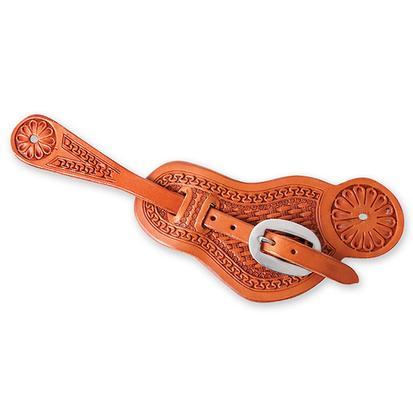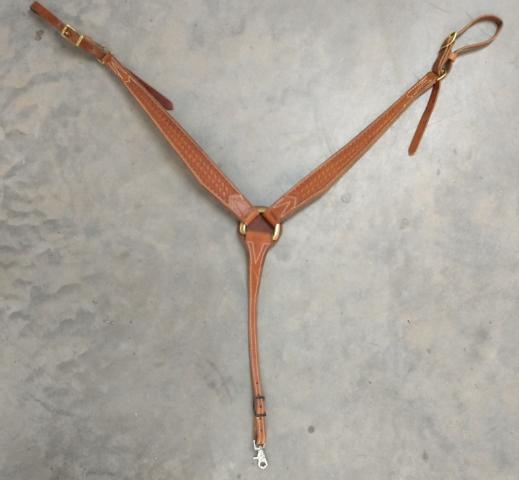-
Posts
267 -
Joined
-
Last visited
Content Type
Profiles
Forums
Events
Blogs
Gallery
Everything posted by bland
-
Are you using conchos to lace through? If so use slightly further apart than the concho.
-
Stylistically you'll want them to compliment your yoke design and the style of chaps. So there can be a variety of sizes. Generally the size range fredk recommended is perfect.
-
In my opinion, I would carve then line. Carving and stamping requires a solid surface to get good impressions. Then add the complexity of carving a rounded object. A swell cover on a western saddle at least has a solid surface under the leather but you're carving at odd angles. I'm thinking with a holster it might be more tricky to keep the solid surface where you need it. I think the bond for gluing will be ok as it will inevitably slightly bigger than it needs to be when you get get the holster closed up. Just another opinion.
-
Top 1/3 of the back for strap goods, breast collars, rear cinch, guitar straps (could be toward the shoulder area of the back it will be a little more flexible). Lay out the projects you have planned for the side. Sounds like the taps depending on length may be your biggest item. Toward the butt of the back will be your firmest.
-
Do you have the Leather Crafter's Journal they came out of? They usually have a picture of a finished product. What I'm seeing on the fold back pattern looks like your buckle piece will be sandwiched between the face piece and the billet strap. Then a keeper will also be through the bag punch holes and is sandwiched between as well. After the billet goes through the ring it will go back through the buckle and the keeper. In the thread through the billet looks like it goes through the 3/4 inch holes but it doesn't show where the buckle will go. Is there another piece of the pattern? Here is a similar style from southtexastack.
-
What do you have planned for the rest of the side? I always liked to cut a set of Stirrup Leathers (top of the back toward the butt end 66" to 72" long) off first. Always good to have an extra set on hand. Then you can cut other straps needed (rear cinch, billets, belts...) This can include your breast collar. Do you have a sketch of what you want? Do you have a favorite to model one after. Here's a pretty simple design all straight cuts. I prefer a ring or d ring in the center. You can have a plate behind or just have the three straps coming off of it. Are you sewing or riveting? You'll need to skive some to make the turns around the rings. I can answer more questions you might have when they come up.
-
What type are you looking to make? Tripping, pulling or roping collar? Are you going to line it? Generally you want to cut strap type goods from towards the top 1/3 of the back. Sometimes however it is what you have left from other priority cuts. Any cut moderately firm skirting will work. Especially if you line it and stitch it.
-

Croc overlay holster and mag pouch.
bland replied to immiketoo's topic in Gun Holsters, Rifle Slings and Knife Sheathes
I think I kinda understand why you're not all the way pleased. I think it is the edges. I find with some exotics they need to be inlaid to get the clean polished edges. You could try one with the croc inlaid on the reinforcement piece. Looks great though. I'd proudly carry it. -
I think trying to re-work the holster you have will be a gamble. You might run yourself out of material to work with. The cut of the original pattern is not right for a cross-draw. You will find it unbalanced and uncomfortable to wear. Just my $.02.
-
bump
-
I like to start trying to blow all the dust out of all the crevices with an air compressor. I don't know how deep you want to go. Cleaning and oiling is an opportunity to check critical saddle parts for safety. I would take the rosettes and hangers off and the screw at base of the swell. Then you can lift the jockeys and inspect the riggings and skirt connectors (whether pockets or tuggs. I also like to at least pull the stirrup straps out far enough to check for damage. Also allows you to clean and oil them. There are some saddle cleaning videos on YouTube. Cary Schwartz, Don Gonzalez, Dennis Moreland and many others.
-

Looking for some feed back and perhaps a lesson.
bland replied to Hairic's topic in Floral and Sheridan Carving
Looks pretty good for a start. Mostly what I see will be taken care of with practice controlling stamp depth and placement. 3 oz leather is difficult to work with especially just starting out. For that style of pattern you will probably want to upgrade your beveller to a steep one. There are a couple guys on Youtube that have free tool along videos for the style of carving you are working on. here are a couple names to search there are others also. Joe Meling, Don Gonzales and Jim Linnell are three that carve floral patterns. Like I said there are more out there and don't mean to slight anyone. They also have paid content. They also have some swivel knife exercises to get your cuts smooth which will also help your tooling. Hope it helps. Practice is the biggest key. -
Barry King sharp curve edger? Smallest size is 1 however. Works good on slot punched holes. I don't usually do anything too thin.
-

Starting A NewHolster
bland replied to AzShooter's topic in Gun Holsters, Rifle Slings and Knife Sheathes
I would oil, dye, paint, resist, antique then finish. -
Not sure this is what you were referring to but here is one method of attaching the back belt.
-
That is a new URL but seems to have at least some of the patterns.
-
The head on the "converting screw" is pretty small. I haven't ever found hardware to work with a head that small. The threads are the same as for a Chicago screw or for screws for cabinet/drawer handles. To use either of them there is time spent cutting and reshaping them to fit your snap. You can make it work but is it worth it? Hopefully someone can point you in the right direction of some bulk supply of "converting screws".
-
Very nice! Where are your pedals?
-
System 135x17 are fabric needles the leather needles that are the same size are 135x16. You will probably want to look for 135x16 DIA (diamond point) or 135x16 TRI (triangle point) or something similar for sewing on leather. The needle and thread size will depend on the look you want. There are several posts on here matching thread and needle sizes with charts. Probably a size 69 or 92 thread to match up with your size 20 needles. 58e52bbf9916d_LeatherNeedlePointsG-B.jpg.6672bb1437b47bf09ab14af20eba55f1.jpg (1347×527) (leatherworker.net)
-
I can see each stitch and it looks quite thin. I think over time with weather and use it would become unsightly and start coming off. Are you looking to build a saddle using this technique? Here is an old post on covering swells. It contains some good information. There are some other posts on this forum that might be helpful.
-
You want to sew a swell cover but not put a welt in it and it is not a fitted cover? Not sure I know what you are describing. I have seen no welt covers with no welts, braided covers and covers with welts but they were all fitted. Do you have pictures of what you are describing?
-
The Juki 1508NH is more heavy duty than the others listed and has a longer stroke. I have the 1508NH and have used the Cobra class 20. The Cobra is probably a little easier to use starting out and significantly less money. Both are great machines. There are a lot of good threads to comparing machines one is below.
-
https://www.homedepot.com/p/1-16-in-x-4-ft-x-8-ft-Plastic-Panel-63003/202090190#overlay




